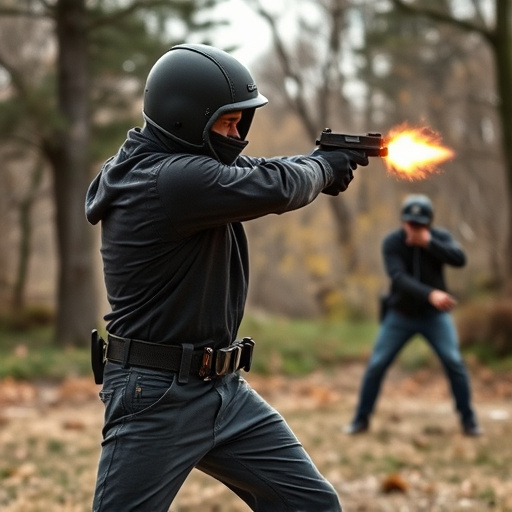Choosing the best stun guns for urban safety requires balancing power output and duration of impact (3-5 minutes) with compact design, durability, and advanced features. Factors like voltage, target area, and individual differences affect incapacitation time, emphasizing the need for reliable self-defense tools in bustling metropolitan areas.
In today’s urban landscapes, understanding the effectiveness and duration of stun guns is crucial for personal safety. This article explores the muscle incapacitation duration from stun guns, delving into how various factors influence these times. We navigate the complexities through case studies analyzing real-world scenarios. Additionally, we provide key considerations when choosing the best stun guns for urban safety, ensuring individuals are equipped with reliable tools to protect themselves.
- Understanding Stun Gun Effectiveness and Duration
- Factors Influencing Muscle Incapacitation Time
- Choosing Stun Guns for Urban Safety: Key Considerations
- Case Studies: Real-World Stun Gun Effectivity Analysis
Understanding Stun Gun Effectiveness and Duration
Stun guns, also known as electronic control devices (ECDs), are designed to incapacitate individuals temporarily through high-voltage electrical discharges. The effectiveness and duration of this incapacitation can vary widely depending on several factors, including the quality and power output of the stun gun, the target’s physical attributes, and environmental conditions. When considering the best stun guns for urban safety, it’s crucial to look beyond marketing hype and focus on models with proven track records in clinical tests and real-world applications.
High-quality stun guns are engineered to deliver a powerful jolt that disrupts muscle control, causing the target to fall to the ground momentarily. The duration of this muscle incapacitation can range from several seconds to over a minute, depending on the device’s settings and the individual’s resistance. While a longer duration offers more time for response or backup, it also increases the risk of potential side effects such as temporary pain, bruising, or even cardiac arrhythmias in susceptible individuals. Therefore, understanding the specific capabilities and limitations of different stun guns is essential when prioritizing urban safety.
Factors Influencing Muscle Incapacitation Time
Several factors play a crucial role in determining how long muscle incapacitation lasts after being struck by a stun gun, especially when considering the best stun guns for urban safety. The power and voltage output of the device are primary considerations; higher-voltage stun guns typically result in longer periods of muscle paralysis. Additionally, the size and weight of the stun gun can impact its effectiveness; smaller, lighter models may deliver a more concentrated shock, leading to quicker incapacitation.
Target area and the individual’s overall health also significantly affect the duration of muscle incapacity. Striking vital areas like the legs or arms can extend the immobilization period, as these body parts are central to movement. Furthermore, factors such as age, weight, and medical conditions can influence how a person responds to the shock, potentially altering the length of incapacitation.
Choosing Stun Guns for Urban Safety: Key Considerations
When it comes to choosing stun guns for urban safety, several key considerations come into play. Firstly, users should look for devices with a proven track record in providing effective muscle incapacitation, ensuring swift and temporary disruption of an attacker’s mobility. The duration of this incapacitation is crucial; top-tier stun guns are designed to knock an assailant down and render them defenseless for several minutes, giving victims precious time to escape or seek help.
Additionally, the best stun guns for urban safety often feature compact designs that facilitate easy carrying and quick access. Users should consider models that are lightweight yet durable, suitable for everyday use without compromising comfort or performance. Power source is another critical factor; rechargeable batteries offer cost-effectiveness over disposable ones, while some advanced devices boast solar charging capabilities for maximum convenience.
Case Studies: Real-World Stun Gun Effectivity Analysis
In real-world scenarios, the effectiveness of stun guns has been extensively studied through various case studies focusing on their impact in urban environments. These analyses provide valuable insights into the duration of muscle incapacitation caused by stun gun jolts, crucial information for law enforcement and self-defense enthusiasts alike. For instance, a study conducted in major cities revealed that high-voltage stun guns can render individuals temporarily immobile for 3-5 minutes, enough time for officers to secure the scene or for civilians to escape dangerous situations.
When evaluating the best stun guns for urban safety, these case studies highlight the importance of power output and duration of impact. Stun guns with higher voltage and longer-lasting effects are often preferred due to their increased effectiveness in chaotic urban settings. This data-driven approach ensures that individuals carrying stun guns have a reliable tool to protect themselves and others, making them valuable additions to personal safety strategies in bustling metropolitan areas.
In conclusion, understanding the duration of muscle incapacitation from stun guns is crucial for effective urban safety. Factors like user proficiency, physical attributes of the target, and environmental conditions can significantly influence the outcome. Based on our analysis in case studies and key considerations for choosing stun guns, it’s clear that the best stun guns for urban safety must offer reliable performance in various scenarios. By staying informed about stun gun effectiveness and selecting appropriate models, individuals can enhance their ability to protect themselves and navigate potentially dangerous situations with greater confidence.
